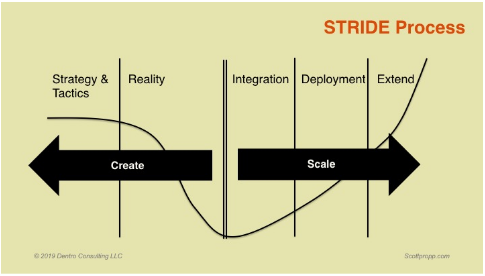“Walk with me for a minute.”
At a session recently, a senior leader asked me to go on a sidebar walk through a windowed view far above the city.
“So if I get what you are saying, there are two ways to fall off the path. One is to use the operations side of the firm to mature early-stage projects.”
“Yes,” I replied. “That would be the most expensive and inefficient use of your resources.”
“And the other is asking a small team to deliver at scale.”
Again, the answer was a resounding yes. Small teams burn out and deliver poor quality because they lack the right mindset to move to scale.
How the STRIDE Model Can Help

Recall from previous posts that STRIDE has two main blocks: the portion of the process that produces scale and the portion of the process that develops insights into workable new products and businesses (for more on the details of STRIDE, see the posts here, here and here).
These two processes work together under one governance model to deliver substantial new growth in complex firms, but they have very different characteristics and ways of behaving. The “secret” underlying the STRIDE model, which makes it so effective, can be found in its three unique characteristics: time cadence, rapid separation of fact from opinion and organizational complexity.
Let’s unpack these one at a time to see what makes STRIDE so powerful:
#1: Cadence
The operational side of the firm has its own deep and powerful clock cycle. It runs on a cadence that involves some variation of plan, do, check and act. It is set up to distill fact from data, and create aligned options to be chosen from and implemented on a firm plan.
Contrast this with the ST & R phases of STRIDE, which we deliberately set up to run quickly. We do this because the key to progress in creative efforts is to avoid dithering. By encouraging teams to make a call and move on, information is created rather than analyzed. It makes the team members from the op’s team very uncomfortable at first, but as the process builds momentum, they come to see how important it is.
This acceleration results in a day of intense work yielding what usually takes a week as teams “schedule in,” “process” and “consider options.”
#2: Rapid Separation of Fact from Opinion
The right-hand side of STRIDE runs on a dominant narrative about the client or customer. It is needed because the right-hand side is populated by numerous specialists and subject matter experts that are needed to build the process to scale. Those actions that align with that avatar are reinforced and all other actions are suppressed. This is important in the optimization of the fulfillment engine to maximize benefits for the firm and the client.
Contrast this with the cross-functional team that by definition needs to be equal parts intellectually objective and collaborative. The work on the left-hand side of the STRIDE curve is to rapidly squeeze out the facts from the opinions, and this is best done through experiment and solid authentic dialogue. We preface this intensity with training in the Complete Growth Leader model, which allows the team to know one another’s default capacities and blind spots. By “fighting like a family” on the right topics, the cross-functional team can quickly get to the unproven areas of the model that can easily be “papered over” by teams that are not being strongly facilitated.
This intellectual rigor is intoxicating and leads to the effort being directed to just the right activity, substantially minimizing hidden issues and blind spots the can lead to a fragile outcome (see this link for examples of otherwise great firms who got this wrong).
#3: Organizational Complexity
To get to facts quickly on the left-hand side, we need a flat, small and highly empowered organization. I have helped teams ranging from three to hundreds of members, and have a strong preference for “cells” of no more than a dozen cross-functional members or so per key deliverable.
Contrast this with large organizations and interchangeable roles on the right-hand side of the STRIDE process. The overhead of communication rises geometrically with membership: project managers learn that a four-member team has six communication channels to manage, but a 10 person team has 45.
By keeping teams small, it localizes the communications and decision making and allows a high-performing, cross-functional effort to literally be completed in days when a large-scale effort might take months or years.
To summarize, STRIDE combines a high-performance left-hand side that is small, fast and highly predisposed to action with an optimization engine to drive scale. Working this way allows the rapid creation of new products and services in a highly efficient way. When working in these patterns, we have found that product development times can literally be cut in half.
If you’d like to talk more about how to build a high-performing effort that includes more than just product development, but the wisdom of the whole firm, we should talk. You can reach me at (847) 651-1014 or by using this link.
Related posts you can benefit from…


